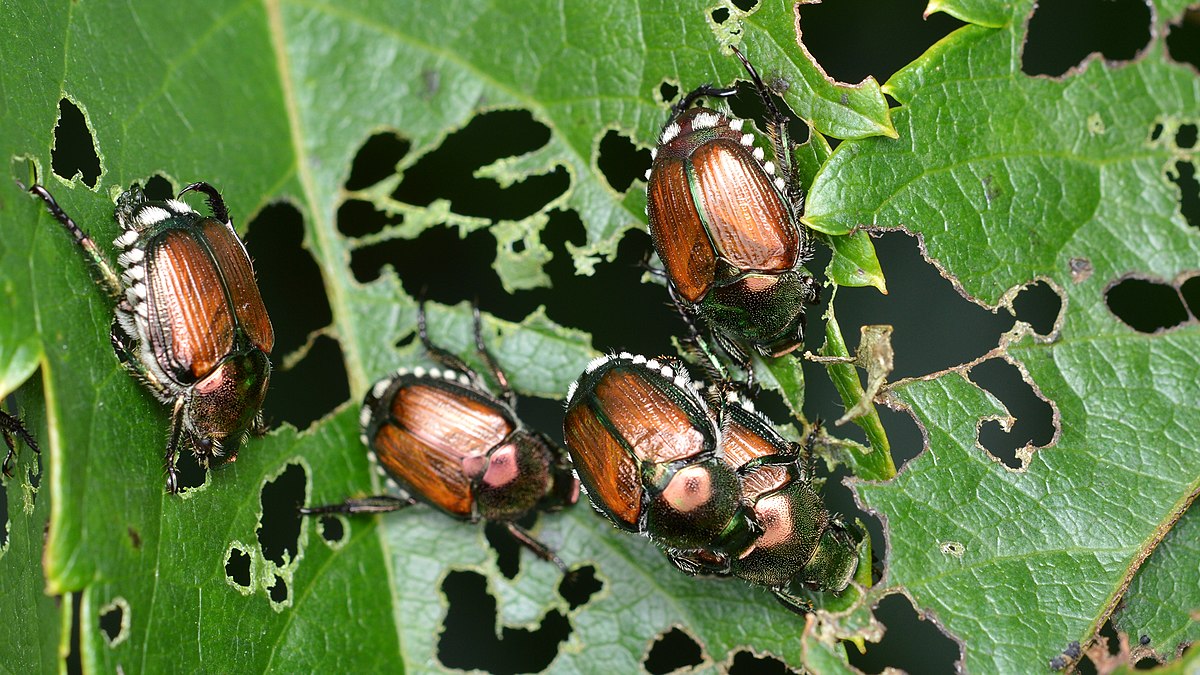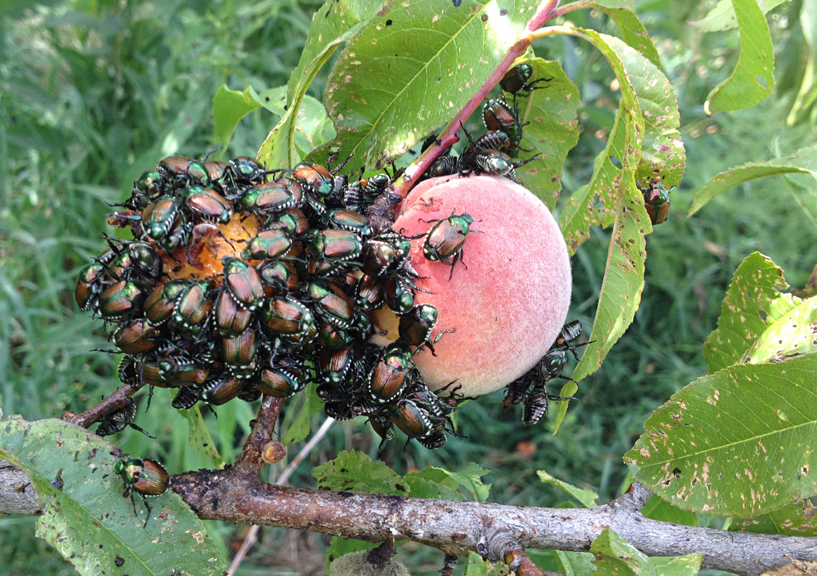Japanese Beetle

Japanese Beetle
(Popillia japonica)
Tags: EDRR
Identification and Reproduction
Identification:
Adults:
- Oval-shaped, approximately 10 mm long and 6 mm wide.
- It is metallic green with metallic copper-brown wing coverings.
- White tufts of hair are found along the sides, under the wing coverings and near the abdomen.
Eggs:
- Elliptical, white and around 1.5 mm long, laid singly about 8 cm deep in the soil.
Larva:
- Grubs are C-shaped, creamy white with a yellow-brown head.
- They are covered in long brown hairs with dispersed short, blunt spines.
- Has a V-shaped arrangement of spines on the last body segment.
Pupa:
- This is the final larval instar stage, they are about the same size of the adult but the legs, antennae and wings are folded closely to the body.
- Depending on age they will appear pale cream, tan or metallic green in the later adult stage.
Reproduction:
- These pests produce one generation per year.
- The female will deposit a total of 40-60 eggs about 8 cm deep in the soil of lawns or other grassy areas.
- Eggs will hatch after two weeks and the larvae will begin to feed on grass roots.
- Adults emerge in the summer and are active for the following 6 to 8 weeks.
Habitat & Ecology
- Turf is the preferred host for the Japanese beetle during the larval stage, but it will also attack roots of other plants.
- Adults will feed on the foliage and fruit of at least 300 different host plants, this includes elm, maple, grape vine, peach, apple, apricot, cherry, plum, rose, zinnia, corn, asparagus, soybean, blueberries, raspberries and blackberries.
- Adult beetles will begin to take flight when temperatures reach above 21°C. They are capable of flying up to 8 km with the wind.
- Adult beetles are most active on warm days between 10am and 3pm.
- They prefer to feed on plants that are exposed to direct sunlight, starting from the top of the plant, feeding downwards.
- In 2017, Japanese beetle was found in False Creek of the City of Vancouver, and is currently undergoing active eradication efforts.
Impacts
- Both adults and larvae will cause plant damage.
- Grubs cause the most damage to pastures, lawns and golf courses.
- Adult beetles damage plants by skeletonizing the foliage, by leaving the viens of leaves.
- They will also feed on the fruits of plants.
- In North America maize is seriously damaged as they feed on maturing silk. This causes malformed kernels and reduces the overall yield.
Management
- Report any suspect specimens to the Canadian Food Inspection Agency.
- Regulated areas have been established to prevent the spread of Japanese beetle. Regulated articles include underground plant parts, soil and other growing media. Regulated articles are restricted to the regulated area and cannot be moved outside of the area without a CFIA Movement Certificate.
- Report any illegal movement of regulated articles to the CFIA.
- There is also a Japanese beetle trapping program across BC intended to detect new populations. Traps are green or/and yellow, with a floral and pheromone lure to capture the pests. These traps have been placed across the Lower Mainland, Fraser Valley, Vancouver Island and BC Interior and high risk introduction locations such as green waste disposal sites.
- Do not remove, relocate or interfere with any Japanese beetle traps.
Resources
For more details refer to the Canadian Food Inspection Agency factsheet on Popillia joponica (Japanese Beetle).
For more information on the eradication program in BC please check out the CFIA's Japanese Beetle Pest Alert.
The Invasive Species Council of BC has a guide on Japanese Beetle Look Alikes.
Header photo (Katja Schulz).






